2.4. The structure of pro- and eukaryotic cells. The relationship between the structure and functions of the parts and organelles of a cell is the basis of its integrity
Basic terms and concepts tested in exam paper: apparatus
Golgi, vacuole, cell membrane, cell theory, leukoplasts, mitochondria, cell organelles, plastids, prokaryotes, ribosomes, chloroplasts, chromoplasts, chromosomes, eukaryotes, nucleus.
Any cell is a system. This means that all its components are interconnected, interdependent and interact with each other. This also means that disruption of one of the elements of a given system leads to changes and disruptions in the functioning of the entire system. A collection of cells forms tissues, various tissues form organs, and organs, interacting and performing a common function, form organ systems. This chain can be continued further, and you can do it yourself. The main thing to understand is that any system has a certain structure, level of complexity and is based on the interaction of the elements that make it up. Below are reference tables that compare the structure and functions of prokaryotic and eukaryotic cells, and also understand their structure and functions. Carefully analyze these tables, because exam papers often ask questions that require knowledge of this material.
2.4.1. Features of the structure of eukaryotic and prokaryotic cells. Comparative data
Comparative characteristics of eukaryotic and prokaryotic cells.
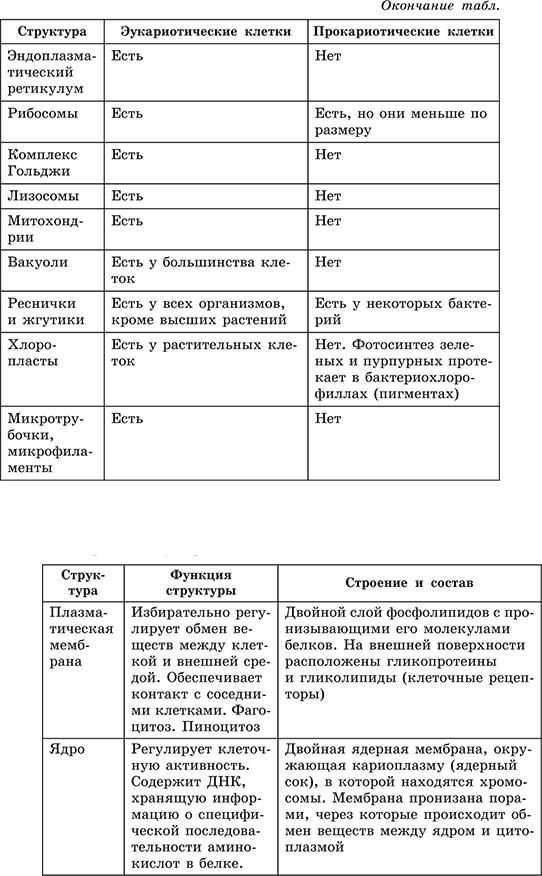
The structure of eukaryotic cells.
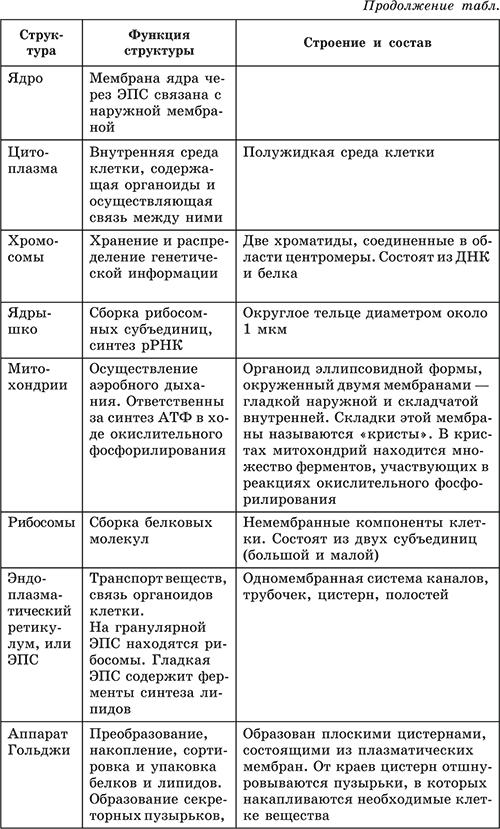
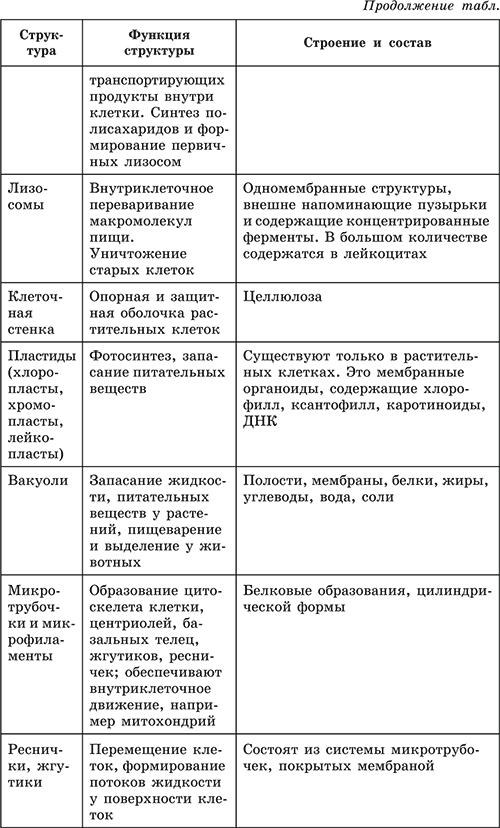
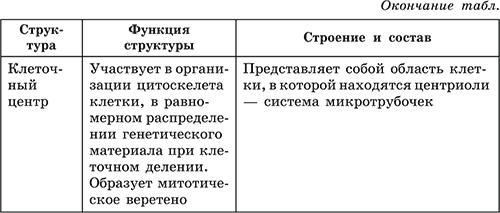
Functions of eukaryotic cells. The cells of unicellular organisms carry out all the functions characteristic of living organisms - metabolism, growth, development, reproduction; capable of adaptation.
Cells multicellular organisms differentiated in structure, depending on the functions they perform. Epithelial, muscular, nervous, connective tissues are formed from specialized cells.
EXAMPLES OF TASKS Part A
A1. Prokaryotic organisms include 1) bacillus 2) hydra 3) amoeba 4) volvox
A2. Cell membrane performs the function
1) protein synthesis
2) transmission of hereditary information
3) photosynthesis
4) phagocytosis and pinocytosis
A3. Indicate the point where the structure of the named cell coincides with its function
1) neuron - abbreviation
2) leukocyte – impulse conduction
3) erythrocyte – transport of gases
4) osteocyte - phagocytosis
A4. Cellular energy is produced in
1) ribosomes 3) nucleus
2) mitochondria 4) Golgi apparatus
A5. Eliminate an unnecessary concept from the proposed list
1) lamblia 3) ciliates
2) plasmodium 4) chlamydomonas
A6. Eliminate an unnecessary concept from the proposed list
1) ribosomes 3) chloroplasts
2) mitochondria 4) starch grains
A7. Cell chromosomes perform the function
1) protein biosynthesis
2) storage of hereditary information
3) formation of lysosomes
4) regulation of metabolism
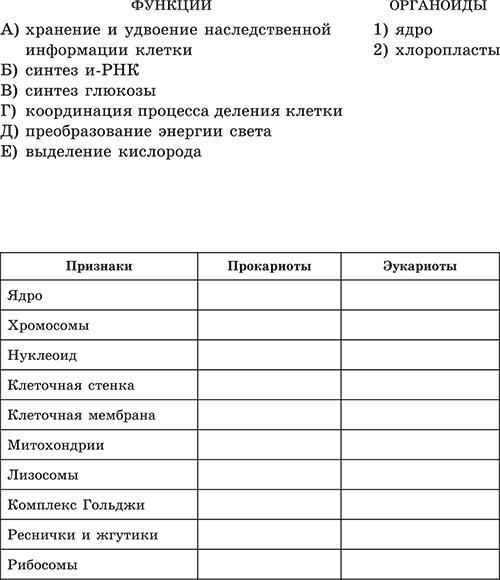
IN 1. Select the functions of chloroplasts from the list provided
1) formation of lysosomes 4) ATP synthesis
2) synthesis of glucose 5) release of oxygen
3) RNA synthesis 6) cellular respiration
AT 2. Select structural features of mitochondria
1) surrounded by a double membrane
2) contain chlorophyll
3) there are cristae
4) folded outer membrane
5) surrounded by a single membrane
6) the inner membrane is rich in V3 enzymes. Match the organelle with its function
AT 4. Fill out the table, marking with “+” or “-” signs the presence of the indicated structures in pro- and eukaryotic cells
C1. Prove that the cell is an integral biological, open system.
2.5. Metabolism: energy and plastic metabolism, their relationship. Enzymes, their chemical nature, role in metabolism. Stages of energy metabolism. Fermentation and respiration. Photosynthesis, its significance, cosmic role. Phases of photosynthesis. Light and dark reactions of photosynthesis, their relationship. Chemosynthesis. The role of chemosynthetic bacteria on Earth
Terms tested in the examination paper: autotrophic organisms
anabolism, anaerobic glycolysis, assimilation, aerobic glycolysis, biological oxidation, fermentation, dissimilation, biosynthesis, heterotrophic organisms, respiration, catabolism, oxygen stage, metabolism, plastic metabolism, preparatory stage, light phase photosynthesis, dark phase of photosynthesis, photolysis of water, photosynthesis, energy metabolism.
2.5.1. Energy and plastic metabolism, their relationship
Metabolism (metabolism) is a set of interconnected processes of synthesis and breakdown of chemicals occurring in the body. Biologists divide it into plastic (anabolism) and energy metabolism (catabolism), which are interconnected. All synthetic processes require substances and energy supplied by fission processes. Decomposition processes are catalyzed by enzymes synthesized during plastic metabolism, using the products and energy of energy metabolism.
For individual processes occurring in organisms, the following terms are used:
Anabolism (assimilation) - synthesis of more complex monomers from simpler ones with the absorption and accumulation of energy in the form chemical bonds in synthesized substances.
Catabolism (dissimilation) is the breakdown of more complex monomers into simpler ones with the release of energy and its storage in the form of high-energy bonds of ATP.
Living beings use light and chemical energy for their life. Green plants - autotrophs - synthesize organic compounds during the process of photosynthesis, using the energy of sunlight. Their source of carbon is carbon dioxide. Many autotrophic prokaryotes obtain energy through the process of chemosynthesis - oxidation organic compounds. For them, the source of energy can be compounds of sulfur, nitrogen, and carbon. Heterotrophs use organic sources of carbon, i.e. feed on ready-made organic matter. Among the plants there may be those that feed in a mixed way (mixotrophically) - sundew, Venus flytrap or even heterotrophically - rafflesia. Among the representatives of unicellular animals, green euglena are considered mixotrophs.
Enzymes, their chemical nature, role in metabolism . Enzymes are always specific proteins - catalysts. The term “specific” means that the object in relation to which this term is used has unique features, properties, and characteristics. Each enzyme has such characteristics because, as a rule, it catalyzes a certain type of reaction. Not a single biochemical reaction in the body occurs without the participation of enzymes. The specificity of the enzyme molecule is explained by its structure and properties. An enzyme molecule has an active center, the spatial configuration of which corresponds to the spatial configuration of the substances with which the enzyme interacts. Having recognized its substrate, the enzyme interacts with it and accelerates its transformation.
Enzymes catalyze all biochemical reactions. Without their participation, the rate of these reactions would decrease hundreds of thousands of times. Examples include reactions such as the participation of RNA polymerase in the synthesis of mRNA on DNA, the effect of urease on urea, the role of ATP synthetase in the synthesis of ATP, and others. Note that many enzymes have names that end in “aza.”
The activity of enzymes depends on temperature, acidity of the environment, and the amount of substrate with which it interacts. As temperature increases, enzyme activity increases. However, this happens up to certain limits, because At high enough temperatures, the protein denatures. The environment in which enzymes can function is different for each group. There are enzymes that are active in an acidic or slightly acidic environment or in an alkaline or slightly alkaline environment. In an acidic environment, gastric juice enzymes are active in mammals. In a slightly alkaline environment, intestinal juice enzymes are active. The pancreatic digestive enzyme is active in an alkaline environment. Most enzymes are active in a neutral environment.
2.5.2. Energy metabolism in the cell (dissimilation)
Energy exchange is a collection chemical reactions the gradual breakdown of organic compounds, accompanied by the release of energy, part of which is spent on the synthesis of ATP. The processes of breakdown of organic compounds in aerobic organisms occur in three stages, each of which is accompanied by
In multicellular organisms it is carried out by digestive enzymes. In unicellular organisms - by lysosome enzymes. At the first stage, protein breakdown occurs
to amino acids, fats to glycerol and fatty acids, polysaccharides to monosaccharides,
nucleic acids to nucleotides. This process is called digestion.
The second stage is oxygen-free (glycolysis). Its biological meaning lies in the beginning of the gradual breakdown and oxidation of glucose with the accumulation of energy in the form of 2 ATP molecules. Glycolysis occurs in the cytoplasm of cells. It consists of several sequential reactions of converting a glucose molecule into two molecules of pyruvic acid (pyruvate) and two molecules of ATP, in the form of which part of the energy released during glycolysis is stored: C6H12O6 + 2ADP + 2P → 2C3H4O3 + 2ATP. The rest of the energy is dissipated as heat.
In yeast and plant cells ( with a lack of oxygen) pyruvate breaks down into ethanol and carbon dioxide. This process is called alcoholic fermentation.
The energy accumulated during glycolysis is too little for organisms that use oxygen for their respiration. That is why in the muscles of animals, including humans, under heavy loads and lack of oxygen, lactic acid (C3H6O3) is formed, which accumulates in the form of lactate. Muscle pain appears. This happens faster in untrained people than in trained people.
The third stage is oxygen, consisting of two sequential processes - the Krebs cycle, named after Nobel laureate Hans Krebs, and oxidative phosphorylation. Its meaning is that during oxygen respiration, pyruvate is oxidized to the final products - carbon dioxide and water, and the energy released during oxidation is stored in the form of 36 ATP molecules. (34 molecules in the Krebs cycle and 2 molecules during oxidative phosphorylation). This energy of decomposition of organic compounds provides reactions of their synthesis in plastic exchange. Oxygen stage arose after accumulation in the atmosphere sufficient quantity molecular oxygen and the appearance of aerobic organisms.
Oxidative phosphorylation or cellular respiration occurs when
the inner membranes of mitochondria, into which electron transport molecules are built. During this stage it is released most of metabolic energy. Carrier molecules transport electrons to molecular oxygen. Some of the energy is dissipated as heat, and some is spent on the formation of ATP.
Total reaction of energy metabolism:
C6H12O6 + 6O2 → 6CO2 + 6H2O + 38ATP.
EXAMPLES OF TASKS Part A
A1. The feeding method of carnivorous animals is called
1) autotrophic 3) heterotrophic
2) mixotrophic 4) chemotrophic
A2. The set of metabolic reactions is called:
1) anabolism 3) dissimilation
2) assimilation 4) metabolism
A3. On preparatory stage energy exchange formation occurs:
1) 2 molecules of ATP and glucose
2) 36 molecules of ATP and lactic acid
3) amino acids, glucose, fatty acids
4) acetic acid and alcohol
A4. Substances that catalyze biochemical reactions in the body are:
1) proteins 3) lipids
2) nucleic acids 4) carbohydrates
A5. The process of ATP synthesis during oxidative phosphorylation occurs in:
1) cytoplasm 3) mitochondria
2) ribosomes 4) Golgi apparatus
A6. The ATP energy stored during energy metabolism is partially used for reactions:
1) preparatory stage
2) glycolysis
3) oxygen stage
4) synthesis of organic compounds A7. The products of glycolysis are:
1) glucose and ATP
2) carbon dioxide and water
3) pyruvic acid and ATP
4) proteins fats carbohydrates
IN 1. Select the events that occur during the preparatory stage of energy metabolism in humans
1) proteins are broken down into amino acids
2) glucose is broken down into carbon dioxide and water
3) 2 ATP molecules are synthesized
4) glycogen is broken down into glucose
5) lactic acid is formed
6) lipids are broken down into glycerol and fatty acids
AT 2. Correlate the processes occurring during energy metabolism with the stages at which they occur
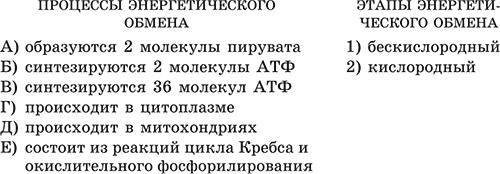
VZ. Determine the sequence of transformations of a piece of raw potato in the process of energy metabolism in the pig’s body:
A) formation of pyruvate B) formation of glucose
C) absorption of glucose into the blood D) formation of carbon dioxide and water
E) oxidative phosphorylation and formation of H2O E) Krebs cycle and formation of CO2
C1. Explain the reasons for fatigue among marathon athletes at distances, and how is it overcome?
2.5.3. Photosynthesis and chemosynthesis
All living things need food and nutrients. When feeding, they use energy stored primarily in organic compounds - proteins, fats, carbohydrates. Heterotrophic organisms, as already mentioned, use food of plant and animal origin, already containing organic compounds. Plants create organic matter during the process of photosynthesis. Research into photosynthesis began in 1630 with the experiments of the Dutchman van Helmont. He proved that plants do not obtain organic matter from the soil, but create it themselves. Joseph Priestley in 1771 proved the “correction” of air with plants. Placed under a glass cover, they absorbed carbon dioxide released by the smoldering splinter. Research has continued, and it has now been established that photosynthesis is the process of formation of organic compounds from carbon dioxide (CO2) and water using light energy and takes place in the chloroplasts of green plants and the green pigments of some photosynthetic bacteria.
Chloroplasts and folds of the cytoplasmic membrane of prokaryotes contain a green pigment - chlorophyll. The chlorophyll molecule is able to be excited under the influence of sunlight and give up its electrons and move them to higher energy levels. This process can be compared to throwing a ball up. Rising, the ball is stored potential energy; falling, he loses her. The electrons do not fall back, but are picked up by electron carriers (NADP+ - nicotinamide diphosphate). In this case, the energy they previously accumulated is partially spent on the formation of ATP. Continuing the comparison with a thrown ball, we can say that the ball, as it falls, heats the surrounding space, and part of the energy of the falling electrons is stored in the form of ATP. The process of photosynthesis is divided into reactions caused by light and reactions associated with carbon fixation. They are called light
and dark phases.
Similarities and differences in the structure of prokaryotic and eukaryotic cells
1. Remember examples of multinucleated cells.
2. What shape can bacteria have?
Prokaryotes.
The oldest organisms on Earth do not have a cell nucleus and are called prokaryotes, that is, prenuclear. They unite into a separate kingdom - Drobyanki, which includes bacteria and blue-green algae.
What are the distinguishing features of prokaryotic cells compared to eukaryotic cells?
Prokaryotic cells, as a rule, are much smaller than those of eukaryotes - their sizes rarely exceed 10 microns, and can be as small as 0.3 X 0.2 microns. True, there are exceptions - a huge bacterial cell size 100 x 10 microns.
Structure and metabolism of prokaryotes. Prokaryotes, as their name suggests, do not have a formed nucleus.
Single ring molecule DNA, located in prokaryotic cells and conventionally called the bacterial chromosome, is located in the center of the cell, but this DNA molecule does not have a shell and is located directly in the cytoplasm (Fig. 36).
On the outside, prokaryotic cells, like eukaryotic cells, are covered with plasma membrane. The membrane structure of these two groups of organisms is the same. The cell membrane of prokaryotes forms numerous invaginations into the cell - mesosomes. They contain enzymes that provide metabolic reactions in a prokaryotic cell. On top of the plasma membrane, prokaryotic cells are covered with a membrane consisting of carbohydrates, reminiscent of a cell wall. plant cells. However, this wall is not formed by fiber, like in plants, but by other polysaccharides - pectin and murein.

2.4. The structure of pro- and eukaryotic cells. The relationship between the structure and functions of the parts and organelles of a cell is the basis of its integrity
Basic terms and concepts tested in the examination paper: apparatus
Golgi, vacuole, cell membrane, cell theory, leukoplasts, mitochondria, cell organelles, plastids, prokaryotes, ribosomes, chloroplasts, chromoplasts, chromosomes, eukaryotes, nucleus.
Any cell is a system. This means that all its components are interconnected, interdependent and interact with each other. This also means that disruption of one of the elements of a given system leads to changes and disruptions in the functioning of the entire system. A collection of cells forms tissues, various tissues form organs, and organs, interacting and performing a common function, form organ systems. This chain can be continued further, and you can do it yourself. The main thing to understand is that any system has a certain structure, level of complexity and is based on the interaction of the elements that make it up. Below are reference tables that compare the structure and functions of prokaryotic and eukaryotic cells, and also understand their structure and functions. Carefully analyze these tables, because exam papers often ask questions that require knowledge of this material.
2.4.1. Features of the structure of eukaryotic and prokaryotic cells. Comparative data
Comparative characteristics of eukaryotic and prokaryotic cells.

The structure of eukaryotic cells.



Functions of eukaryotic cells. The cells of unicellular organisms carry out all the functions characteristic of living organisms - metabolism, growth, development, reproduction; capable of adaptation.
The cells of multicellular organisms are differentiated by structure, depending on the functions they perform. Epithelial, muscle, nervous, and connective tissues are formed from specialized cells.
EXAMPLES OF TASKS Part A
A1. Prokaryotic organisms include 1) bacillus 2) hydra 3) amoeba 4) volvox
A2. The cell membrane performs the function
1) protein synthesis
2) transmission of hereditary information
3) photosynthesis
4) phagocytosis and pinocytosis
A3. Indicate the point where the structure of the named cell coincides with its function
1) neuron - abbreviation
2) leukocyte – impulse conduction
3) erythrocyte – transport of gases
4) osteocyte - phagocytosis
A4. Cellular energy is produced in
1) ribosomes 3) nucleus
2) mitochondria 4) Golgi apparatus
A5. Eliminate an unnecessary concept from the proposed list
1) lamblia 3) ciliates
2) plasmodium 4) chlamydomonas
A6. Eliminate an unnecessary concept from the proposed list
1) ribosomes 3) chloroplasts
2) mitochondria 4) starch grains
A7. Cell chromosomes perform the function
1) protein biosynthesis
2) storage of hereditary information
3) formation of lysosomes
4) regulation of metabolism

IN 1. Select the functions of chloroplasts from the list provided
1) formation of lysosomes 4) ATP synthesis
2) synthesis of glucose 5) release of oxygen
3) RNA synthesis 6) cellular respiration
AT 2. Select structural features of mitochondria
1) surrounded by a double membrane
2) contain chlorophyll
3) there are cristae
4) folded outer membrane
5) surrounded by a single membrane
6) the inner membrane is rich in V3 enzymes. Match the organelle with its function
AT 4. Fill out the table, marking with “+” or “-” signs the presence of the indicated structures in pro- and eukaryotic cells
C1. Prove that the cell is an integral biological, open system.
2.5. Metabolism: energy and plastic metabolism, their relationship. Enzymes, their chemical nature, role in metabolism. Stages of energy metabolism. Fermentation and respiration. Photosynthesis, its significance, cosmic role. Phases of photosynthesis. Light and dark reactions of photosynthesis, their relationship. Chemosynthesis. The role of chemosynthetic bacteria on Earth
Terms tested in the examination paper: autotrophic organisms
anabolism, anaerobic glycolysis, assimilation, aerobic glycolysis, biological oxidation, fermentation, dissimilation, biosynthesis, heterotrophic organisms, respiration, catabolism, oxygen stage, metabolism, plastic metabolism, preparatory stage, light phase of photosynthesis, dark phase of photosynthesis, photolysis of water, photosynthesis, energy metabolism.
2.5.1. Energy and plastic metabolism, their relationship
Metabolism (metabolism) is a set of interconnected processes of synthesis and breakdown of chemicals occurring in the body. Biologists divide it into plastic (anabolism) and energy metabolism (catabolism), which are interconnected. All synthetic processes require substances and energy supplied by fission processes. Decomposition processes are catalyzed by enzymes synthesized during plastic metabolism, using the products and energy of energy metabolism.
For individual processes occurring in organisms, the following terms are used:
Anabolism (assimilation) is the synthesis of more complex monomers from simpler ones with the absorption and accumulation of energy in the form of chemical bonds in the synthesized substances.
Catabolism (dissimilation) is the breakdown of more complex monomers into simpler ones with the release of energy and its storage in the form of high-energy bonds of ATP.
Living beings use light and chemical energy for their life. Green plants - autotrophs - synthesize organic compounds during the process of photosynthesis, using the energy of sunlight. Their source of carbon is carbon dioxide. Many autotrophic prokaryotes obtain energy through the process of chemosynthesis - the oxidation of inorganic compounds. For them, the source of energy can be compounds of sulfur, nitrogen, and carbon. Heterotrophs use organic sources of carbon, i.e. feed on ready-made organic matter. Among the plants there may be those that feed in a mixed way (mixotrophically) - sundew, Venus flytrap or even heterotrophically - rafflesia. Among the representatives of unicellular animals, green euglena are considered mixotrophs.
Enzymes, their chemical nature, role in metabolism . Enzymes are always specific proteins - catalysts. The term “specific” means that the object in relation to which this term is used has unique features, properties, and characteristics. Each enzyme has such characteristics because, as a rule, it catalyzes a certain type of reaction. Not a single biochemical reaction in the body occurs without the participation of enzymes. The specificity of the enzyme molecule is explained by its structure and properties. An enzyme molecule has an active center, the spatial configuration of which corresponds to the spatial configuration of the substances with which the enzyme interacts. Having recognized its substrate, the enzyme interacts with it and accelerates its transformation.
Enzymes catalyze all biochemical reactions. Without their participation, the rate of these reactions would decrease hundreds of thousands of times. Examples include reactions such as the participation of RNA polymerase in the synthesis of mRNA on DNA, the effect of urease on urea, the role of ATP synthetase in the synthesis of ATP, and others. Note that many enzymes have names that end in “aza.”
The activity of enzymes depends on temperature, acidity of the environment, and the amount of substrate with which it interacts. As temperature increases, enzyme activity increases. However, this happens up to certain limits, because At high enough temperatures, the protein denatures. The environment in which enzymes can function is different for each group. There are enzymes that are active in an acidic or slightly acidic environment or in an alkaline or slightly alkaline environment. In an acidic environment, gastric juice enzymes are active in mammals. In a slightly alkaline environment, intestinal juice enzymes are active. The pancreatic digestive enzyme is active in an alkaline environment. Most enzymes are active in a neutral environment.
2.5.2. Energy metabolism in the cell (dissimilation)
Energy exchange is a set of chemical reactions of the gradual decomposition of organic compounds, accompanied by the release of energy, part of which is spent on the synthesis of ATP. The processes of breakdown of organic compounds in aerobic organisms occur in three stages, each of which is accompanied by
In multicellular organisms it is carried out by digestive enzymes. In unicellular organisms - by lysosome enzymes. At the first stage, protein breakdown occurs
to amino acids, fats to glycerol and fatty acids, polysaccharides to monosaccharides,
nucleic acids to nucleotides. This process is called digestion.
The second stage is oxygen-free (glycolysis). Its biological meaning lies in the beginning of the gradual breakdown and oxidation of glucose with the accumulation of energy in the form of 2 ATP molecules. Glycolysis occurs in the cytoplasm of cells. It consists of several sequential reactions of converting a glucose molecule into two molecules of pyruvic acid (pyruvate) and two molecules of ATP, in the form of which part of the energy released during glycolysis is stored: C6H12O6 + 2ADP + 2P → 2C3H4O3 + 2ATP. The rest of the energy is dissipated as heat.
In yeast and plant cells ( with a lack of oxygen) pyruvate breaks down into ethyl alcohol and carbon dioxide. This process is called alcoholic fermentation.
The energy accumulated during glycolysis is too little for organisms that use oxygen for their respiration. That is why in the muscles of animals, including humans, under heavy loads and lack of oxygen, lactic acid (C3H6O3) is formed, which accumulates in the form of lactate. Muscle pain appears. This happens faster in untrained people than in trained people.
The third stage is oxygen, consisting of two sequential processes - the Krebs cycle, named after Nobel laureate Hans Krebs, and oxidative phosphorylation. Its meaning is that during oxygen respiration, pyruvate is oxidized to the final products - carbon dioxide and water, and the energy released during oxidation is stored in the form of 36 ATP molecules. (34 molecules in the Krebs cycle and 2 molecules during oxidative phosphorylation). This energy of decomposition of organic compounds provides reactions of their synthesis in plastic exchange. The oxygen stage arose after the accumulation of a sufficient amount of molecular oxygen in the atmosphere and the appearance of aerobic organisms.
Oxidative phosphorylation or cellular respiration occurs when
the inner membranes of mitochondria, into which electron transport molecules are built. During this stage, most of the metabolic energy is released. Carrier molecules transport electrons to molecular oxygen. Some of the energy is dissipated as heat, and some is spent on the formation of ATP.
Total reaction of energy metabolism:
C6H12O6 + 6O2 → 6CO2 + 6H2O + 38ATP.
EXAMPLES OF TASKS Part A
A1. The feeding method of carnivorous animals is called
1) autotrophic 3) heterotrophic
2) mixotrophic 4) chemotrophic
A2. The set of metabolic reactions is called:
1) anabolism 3) dissimilation
2) assimilation 4) metabolism
A3. At the preparatory stage of energy metabolism, the formation occurs:
1) 2 molecules of ATP and glucose
2) 36 molecules of ATP and lactic acid
3) amino acids, glucose, fatty acids
4) acetic acid and alcohol
A4. Substances that catalyze biochemical reactions in the body are:
1) proteins 3) lipids
2) nucleic acids 4) carbohydrates
A5. The process of ATP synthesis during oxidative phosphorylation occurs in:
1) cytoplasm 3) mitochondria
2) ribosomes 4) Golgi apparatus
A6. The ATP energy stored during energy metabolism is partially used for reactions:
1) preparatory stage
2) glycolysis
3) oxygen stage
4) synthesis of organic compounds A7. The products of glycolysis are:
1) glucose and ATP
2) carbon dioxide and water
3) pyruvic acid and ATP
4) proteins fats carbohydrates
IN 1. Select the events that occur during the preparatory stage of energy metabolism in humans
1) proteins are broken down into amino acids
2) glucose is broken down into carbon dioxide and water
3) 2 ATP molecules are synthesized
4) glycogen is broken down into glucose
5) lactic acid is formed
6) lipids are broken down into glycerol and fatty acids
AT 2. Correlate the processes occurring during energy metabolism with the stages at which they occur

VZ. Determine the sequence of transformations of a piece of raw potato in the process of energy metabolism in the pig’s body:
A) formation of pyruvate B) formation of glucose
C) absorption of glucose into the blood D) formation of carbon dioxide and water
E) oxidative phosphorylation and formation of H2O E) Krebs cycle and formation of CO2
C1. Explain the reasons for fatigue among marathon athletes at distances, and how is it overcome?
2.5.3. Photosynthesis and chemosynthesis
All living things need food and nutrients. When feeding, they use energy stored primarily in organic compounds - proteins, fats, carbohydrates. Heterotrophic organisms, as already mentioned, use food of plant and animal origin, already containing organic compounds. Plants create organic matter through the process of photosynthesis. Research into photosynthesis began in 1630 with the experiments of the Dutchman van Helmont. He proved that plants do not obtain organic matter from the soil, but create it themselves. Joseph Priestley in 1771 proved the “correction” of air with plants. Placed under a glass cover, they absorbed carbon dioxide released by the smoldering splinter. Research has continued, and it has now been established that photosynthesis is the process of formation of organic compounds from carbon dioxide (CO2) and water using light energy and takes place in the chloroplasts of green plants and the green pigments of some photosynthetic bacteria.
Chloroplasts and folds of the cytoplasmic membrane of prokaryotes contain a green pigment - chlorophyll. The chlorophyll molecule is capable of being excited by sunlight and donating its electrons and moving them to higher energy levels. This process can be compared to throwing a ball up. As the ball rises, it stores potential energy; falling, he loses her. The electrons do not fall back, but are picked up by electron carriers (NADP+ - nicotinamide diphosphate). In this case, the energy they previously accumulated is partially spent on the formation of ATP. Continuing the comparison with a thrown ball, we can say that the ball, as it falls, heats the surrounding space, and part of the energy of the falling electrons is stored in the form of ATP. The process of photosynthesis is divided into reactions caused by light and reactions associated with carbon fixation. They are called light
and dark phases.
There are 2 types of cell organization: prokaryotic (prenuclear) cells and eukaryotic (nuclear) cells.
Structure of a eukaryotic cell
A eukaryotic cell consists of three main parts: the nucleus, the cytoplasm and cell wall. Eukaryotes include protozoa, invertebrate and vertebrate animals, higher plants, fungi and algae (without blue-green and prochlorophytes). Animal and plant cells differ in the following parameters. In cells higher plants there are no centrioles, they have a rigid cell wall, plasmodesmata, a vacuole with cell sap, plastids. In algae cells belonging to different taxa, centrioles, a cell wall, plastids and a vacuole with cell sap may be present or absent. Fungal cells combine some characteristics of animal and plant cells. Like plant cells, they have a rigid cell wall, but it contains chitin, like the exoskeleton of arthropods. Fungal cells lack plastids, they have urea in their metabolism, and they store not starch, but, as in animal liver cells, glycogen.
Structure of a prokaryotic cell
A prokaryotic cell is structured as follows. The main feature of these cells is the absence of a morphologically expressed nucleus, but there is a zone in which DNA is located (nucleoid). Ribosomes and cytoplasmic membranes are located in the cytoplasm, but they lack a set of other organelles found in eukaryotic cells, such as the endoplasmic reticulum, Golgi apparatus, lysosomes, mitochondria, plastids, centrioles, microtubules. On the outside, the contents of a prokaryotic cell are covered with a cytoplasmic membrane, which plays a barrier function between the cytoplasm of the cell itself and the external environment. On top of the cytoplasmic membrane is a cell wall (envelope). At the same time, prokaryotic and eukaryotic cells have both common features buildings:
Covered with a cytoplasmic membrane that functions as a system for the active transport of substances from cell to cell;
Protein synthesis occurs on ribosomes;
The processes of RNA synthesis and DNA replication are similar;
Bioenergetic processes are similar.
All bacteria have a prokaryotic cell structure, including archaebacteria and cyanobacteria (blue-green algae). Prokaryotic cells may differ from each other in the structure of the cell wall, the folding of the cytoplasmic membranes, the number and properties of intracellular vacuoles, the number and structure of cytoplasmic processes, etc., but overall plan the structure remains constant.
